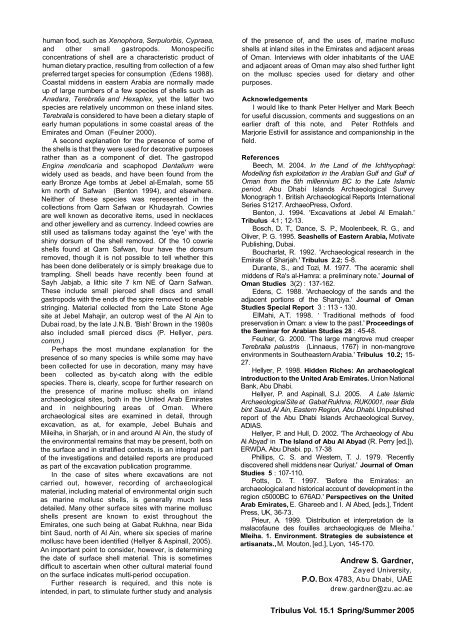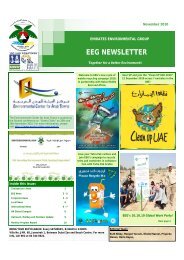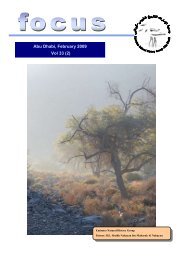Oman (Lepidoptera: Pieridae) - Al Ain Chapter, Emirates Natural ...
Oman (Lepidoptera: Pieridae) - Al Ain Chapter, Emirates Natural ...
Oman (Lepidoptera: Pieridae) - Al Ain Chapter, Emirates Natural ...
You also want an ePaper? Increase the reach of your titles
YUMPU automatically turns print PDFs into web optimized ePapers that Google loves.
human food, such as Xenophora, Serpulorbis, Cypraea,<br />
and other small gastropods. Monospecific<br />
concentrations of shell are a characteristic product of<br />
human dietary practice, resulting from collection of a few<br />
preferred target species for consumption (Edens 1988).<br />
Coastal middens in eastern Arabia are normally made<br />
up of large numbers of a few species of shells such as<br />
Anadara, Terebralia and Hexaplex, yet the latter two<br />
species are relatively uncommon on these inland sites.<br />
Terebralia is considered to have been a dietary staple of<br />
early human populations in some coastal areas of the<br />
<strong>Emirates</strong> and <strong>Oman</strong> (Feulner 2000).<br />
A second explanation for the presence of some of<br />
the shells is that they were used for decorative purposes<br />
rather than as a component of diet. The gastropod<br />
Engina mendicaria and scaphopod Dentalium were<br />
widely used as beads, and have been found from the<br />
early Bronze Age tombs at Jebel al-Emalah, some 55<br />
km north of Safwan (Benton 1994), and elsewhere.<br />
Neither of these species was represented in the<br />
collections from Qarn Safwan or Khudayrah. Cowries<br />
are well known as decorative items, used in necklaces<br />
and other jewellery and as currency. Indeed cowries are<br />
still used as talismans today against the 'eye' with the<br />
shiny dorsum of the shell removed. Of the 10 cowrie<br />
shells found at Qarn Safwan, four have the dorsum<br />
removed, though it is not possible to tell whether this<br />
has been done deliberately or is simply breakage due to<br />
trampling. Shell beads have recently been found at<br />
Sayh Jabjab, a lithic site 7 km NE of Qarn Safwan.<br />
These include small pierced shell discs and small<br />
gastropods with the ends of the spire removed to enable<br />
stringing. Material collected from the Late Stone Age<br />
site at Jebel Mahajir, an outcrop west of the <strong>Al</strong> <strong>Ain</strong> to<br />
Dubai road, by the late J.N.B. 'Bish' Brown in the 1980s<br />
also included small pierced discs (P. Hellyer, pers.<br />
comm.)<br />
Perhaps the most mundane explanation for the<br />
presence of so many species is while some may have<br />
been collected for use in decoration, many may have<br />
been collected as by-catch along with the edible<br />
species. There is, clearly, scope for further research on<br />
the presence of marine mollusc shells on inland<br />
archaeological sites, both in the United Arab <strong>Emirates</strong><br />
and in neighbouring areas of <strong>Oman</strong>. Where<br />
archaeological sites are examined in detail, through<br />
excavation, as at, for example, Jebel Buhais and<br />
Mileiha, in Sharjah, or in and around <strong>Al</strong> <strong>Ain</strong>, the study of<br />
the environmental remains that may be present, both on<br />
the surface and in stratified contexts, is an integral part<br />
of the investigations and detailed reports are produced<br />
as part of the excavation publication programme.<br />
In the case of sites where excavations are not<br />
carried out, however, recording of archaeological<br />
material, including material of environmental origin such<br />
as marine mollusc shells, is generally much less<br />
detailed. Many other surface sites with marine mollusc<br />
shells present are known to exist throughout the<br />
<strong>Emirates</strong>, one such being at Gabat Rukhna, near Bida<br />
bint Saud, north of <strong>Al</strong> <strong>Ain</strong>, where six species of marine<br />
mollusc have been identified (Hellyer & Aspinall, 2005).<br />
An important point to consider, however, is determining<br />
the date of surface shell material. This is sometimes<br />
difficult to ascertain when other cultural material found<br />
on the surface indicates multi-period occupation.<br />
Further research is required, and this note is<br />
intended, in part, to stimulate further study and analysis<br />
of the presence of, and the uses of, marine mollusc<br />
shells at inland sites in the <strong>Emirates</strong> and adjacent areas<br />
of <strong>Oman</strong>. Interviews with older inhabitants of the UAE<br />
and adjacent areas of <strong>Oman</strong> may also shed further light<br />
on the mollusc species used for dietary and other<br />
purposes.<br />
Acknowledgements<br />
I would like to thank Peter Hellyer and Mark Beech<br />
for useful discussion, comments and suggestions on an<br />
earlier draft of this note, and Peter Rothfels and<br />
Marjorie Estivill for assistance and companionship in the<br />
field.<br />
References<br />
Beech, M. 2004. In the Land of the Ichthyophagi:<br />
Modelling fish exploitation in the Arabian Gulf and Gulf of<br />
<strong>Oman</strong> from the 5th millennium BC to the Late Islamic<br />
period. Abu Dhabi Islands Archaeological Survey<br />
Monograph 1. British Archaeological Reports International<br />
Series S1217. ArchaeoPress, Oxford.<br />
Benton, J. 1994. 'Excavations at Jebel <strong>Al</strong> Emalah.'<br />
Tribulus 4.1 ; 12-1 3.<br />
Bosch, D. T., Dance, S. P., Moolenbeek, R. G., and<br />
Oliver, P. G. 1995. Seashells of Eastern Arabia, Motivate<br />
Publishing, Dubai.<br />
Boucharlat, R. 1992. 'Archaeological research in the<br />
Emirate of Sharjah.' Tribulus 2.2; 5-8.<br />
Durante, S., and Tozi, M. 1977. 'The aceramic shell<br />
middens of Ra's al-Hamra: a preliminary note.' Journal of<br />
<strong>Oman</strong> Studies 3(2) : 137-162.<br />
Edens, C. 1988. 'Archaeology of the sands and the<br />
adjacent portions of the Sharqiya.' Journal of <strong>Oman</strong><br />
Studies Special Report 3 : 11 3 - 130.<br />
ElMahi, A.T. 1998. ' Traditional methods of food<br />
preservation in <strong>Oman</strong>: a view to the past.' Proceedings of<br />
the Seminar for Arabian Studies 28 : 45-48.<br />
Feulner, G. 2000. 'The large mangrove mud creeper<br />
Terebralia palustris (Linnaeus, 1767) in non-mangrove<br />
environments in Southeastern Arabia.' Tribulus 10.2; 15-<br />
27.<br />
Hellyer, P. 1998. Hidden Riches: An archaeological<br />
introduction to the United Arab <strong>Emirates</strong>. Union National<br />
Bank, Abu Dhabi.<br />
Hellyer, P. and Aspinall, S.J. 2005. A Late Islamic<br />
Archaeological Site at Gabat Rukhna, RUK0001, near Bida<br />
bint Saud, <strong>Al</strong> <strong>Ain</strong>, Eastern Region, Abu Dhabi. Unpublished<br />
report of the Abu Dhabi Islands Archaeological Survey,<br />
ADIAS.<br />
Hellyer, P. and Hull, D. 2002. 'The Archaeology of Abu<br />
<strong>Al</strong> Abyad' in The Island of Abu <strong>Al</strong> Abyad (R. Perry [ed.]),<br />
ERWDA. Abu Dhabi. pp. 17-38<br />
Phillips, C. S. and Western, T. J. 1979. 'Recently<br />
discovered shell middens near Quriyat.' Journal of <strong>Oman</strong><br />
Studies 5 : 107-110.<br />
Potts, D. T. 1997. 'Before the <strong>Emirates</strong>: an<br />
archaeological and historical account of development in the<br />
region c5000BC to 676AD.' Perspectives on the United<br />
Arab <strong>Emirates</strong>, E. Ghareeb and I. <strong>Al</strong> Abed, [eds.], Trident<br />
Press, UK, 36-73.<br />
Prieur, A. 1999. 'Distribution et interpretation de la<br />
malacofaune des fouilles archaeologiques de Mleiha.'<br />
Mleiha. 1. Environment. Strategies de subsistence et<br />
artisanats., M. Mouton, [ed.], Lyon, 145-170.<br />
Andrew S. Gardner,<br />
Zayed University,<br />
P.O. Box 4783, Abu Dhabi, UAE<br />
drew.gardner@zu.ac.ae<br />
Tribulus Vol. 15.1 Spring/Summer 2005




